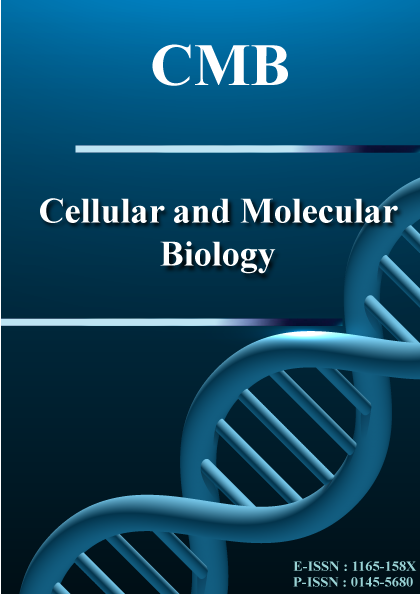Issue
Copyright (c) 2025 Samira Krid, Najeh Krayem, Olfa Frikha-Gargouri, Abir Ben Bacha, Mona Alonazi, Habib Horchani, Mohamed Ali Triki

This work is licensed under a Creative Commons Attribution-NonCommercial-NoDerivatives 4.0 International License.
The undersigned hereby assign all rights, included but not limited to copyright, for this manuscript to CMB Association upon its submission for consideration to publication on Cellular and Molecular Biology. The rights assigned include, but are not limited to, the sole and exclusive rights to license, sell, subsequently assign, derive, distribute, display and reproduce this manuscript, in whole or in part, in any format, electronic or otherwise, including those in existence at the time this agreement was signed. The authors hereby warrant that they have not granted or assigned, and shall not grant or assign, the aforementioned rights to any other person, firm, organization, or other entity. All rights are automatically restored to authors if this manuscript is not accepted for publication.Evaluating the antifungal potential of six essential oils against fungi causing wilt and dieback on olive trees
Corresponding Author(s) : Abir Ben Bacha
Cellular and Molecular Biology,
Vol. 71 No. 4: Issue 4
Abstract
Essential oils, known for their antimicrobial properties, are being investigated as natural alternatives to synthetic fungicides in agriculture. This study aimed to assess the chemical composition of six commercial essential oils (clove, tea tree, rosemary, thyme, oregano, and garlic) and to evaluate their fungistatic and/or fungicidal activity against six phytopathogenic fungi that cause significant damage to olive trees in Tunisia. For this purpose, the essential oils' qualitative and quantitative chemical compositions were analyzed using gas chromatography-mass spectrometry. The antifungal activity was assessed using the poisoned substrate method at different concentrations (250, 500, 1000, and 4000 ppm). Results showed that the chemical composition analysis revealed that monoterpenoids were the dominant fraction in all oils except clove and garlic, which were primarily composed of eugenol (96.28%) and trisulfide (31.97%), respectively. The antifungal activity results showed that lower concentrations (250, 500, 1000 ppm) of tea tree, rosemary, thyme, and oregano oils had limited inhibitory effects on the tested fungi. However, Biscogniauxia mediterranea was highly sensitive to clove, garlic, and rosemary oils at 4000 ppm. Fusarium oxysporum, Fusarium solani, Verticillium dahliae, and Lasiodiplodia theobromae were mainly inhibited by clove oil at concentrations ranging from 500 to 4000 ppm, while Rhizoctonia bataticola was inhibited by clove and garlic oils at high concentrations. In conclusion, among the tested essential oils, clove oil demonstrated the highest antifungal efficacy, making it a promising natural alternative to synthetic fungicides for controlling olive tree phytopathogenic fungi.
Keywords
Download Citation
Endnote/Zotero/Mendeley (RIS)BibTeX




